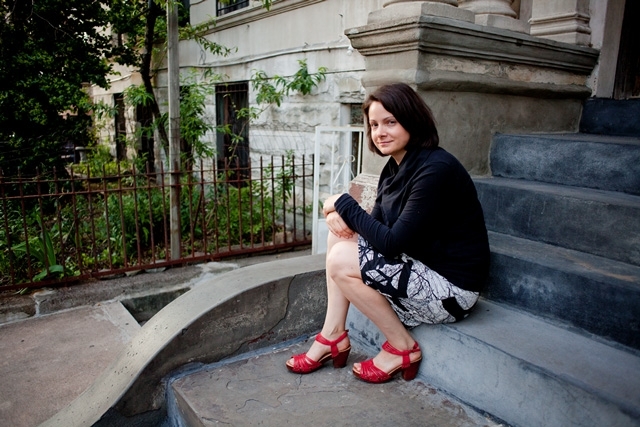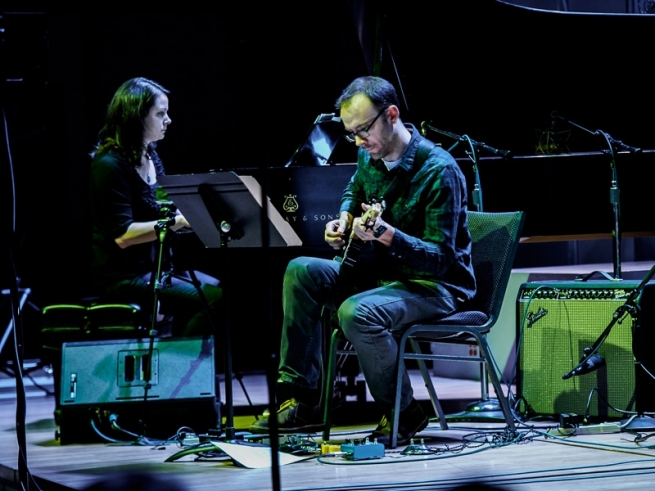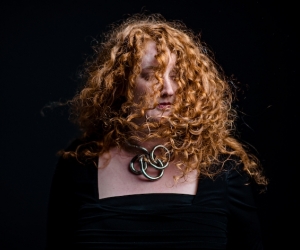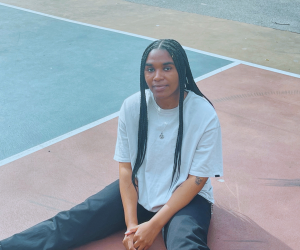
Kris Davis is working on setting a routine. It’s not an unusual task. It’s one that new mothers all over Brooklyn who work odd hours have to contend with. But it’s a challenge. She’s up at six a.m. every day with her son, who turned one in July 2014. While on new-mother duty, Davis is busily trying to find time to visit her studio, where her Kawai grand piano has been housed since her son’s birth, and to return some phone calls about gigs and recordings—an ever more important part of the day, as demand for the improviser and composer has steadily increased over the last few years. Having a husband (guitarist Nate Radley) in the same line of work doesn’t make scheduling any easier.
“I’m constantly trying to refine it, but it keeps changing because my son is changing all the time,” Davis says, on a July afternoon at a café near her studio in the Gowanus section of Brooklyn. “I try to get at least an hour or two to get some music in and then an hour or two of business. Going out and playing gigs at night, and then getting up at six, is really, really hard, but it’s really, really great, too. I wouldn’t change a thing.”
The Calgary-born pianist gave her son his first musical present before he was even born. Her 2014 trio CD Waiting For You To Grow (Clean Feed), with bassist John Hébert and drummer Tom Rainey, contains a set of six compositions that were written while she was pregnant. The maternal angle is hard to miss—from the cover (a line drawing of a pair of hands tending to a small plant) to her brief liner notes and photo inside. But the disc, her tenth as a leader or coleader, is a far cry from lullabies or Swing Time for Babies. “Whirly Swirly,” the opening track, moves through a surprising amount of terrain, including some unexpected pounding passages, in fifteen and a half minutes. And while the bouncing “Hiccups” might appeal to the diaper set, the somber “Berio” is clearly written from a mature perspective.
Davis is also writing two books of études for her son—one for kids, and one for advanced pianists. “I am trying to pare down the idea of this tonal and nontonal world and bring it down to the level of a beginning pianist,” Davis explains. “I want to write something for my son like Bach wrote for his kids.” The books, of course, aren’t just for her son, but for her students and future generations of players, as well.
“I’m still teaching from the books that I grew up with,” says Davis, who teaches piano to young children and draws from her memories of lessons in Calgary in designing her curriculum. “But there are things I want to introduce to kids that will make piano lessons more fun for them. I’ve been teaching Monk to beginners. They love the sound. You can break down his music into shapes, and see the shape of it on the piano. Kids memorize these things; they see what it looks like. Many students want to connect with the music through the sound and through the way it feels—the reading can come later. This approach is the opposite of what I did as a student.”
What Davis did was a common route for young people finding their way into improvised music. She started classical piano lessons at age six. At thirteen, she joined her school’s jazz band, where she found inspiration—and a teacher who recognized it. Soon she was listening to Miles Davis records and transcribing Herbie Hancock’s solos. “Some people are good at a lot of things, but I didn’t feel like I was good at a lot of things,” Davis says of her childhood. “As soon as I started music lessons, it all kind of clicked.” Davis eventually made her way to Toronto, where she found work playing standards and accompanying singers. But, by her own account, she wasn’t doing much in terms of improvisation. While attending the jazz program at The Banff Centre in 1997 and again in 2000, she met New York-based musicians such as pianist Angelica Sanchez, trumpeter Dave Ballou, Edmonton-raised drummer Owen Howard, and, significantly, saxophonist Tony Malaby—artists who were a part of a scene in which Davis would soon be active. When she made the move to New York in 2001, Malaby became an early ally. “We played a lot, talked about music, and he encouraged me to try things like composing, which I hadn’t really done yet,” she recalls.
“I was definitely more mainstream before I moved to New York and discovered the scene here. It was difficult to figure out how to make the shift. I took a lot of ideas and things I had learned from studying classical piano and mixed them with jazz. That’s how I worked on my technique. There is so much to draw on from the classical language. There are so many different approaches to the piano.”
That classical training, which never left her entirely, has been surfacing again in Davis’ more recent work. “Berio,” on her latest trio album, is dedicated to Italian composer Luciano Berio. A piece based on György Ligeti’s piano étude Der Zauberlehrling appears on her 2013 solo album Massive Threads (Thirsty Ear), one of two stunning solo albums Davis has produced since moving to New York. Over the past couple of years, Davis has plunged into the music of Berio. “He uses these voicings that people use for jazz, but he uses them more texturally, with variations in density. They seem very connected to jazz, but are approached in a different way,” she says. “And I’m always coming back to Ligeti. I love that he had these very simple ideas that develop into the most complex things you ever heard.” Massive Threads also includes a wonderfully fragmented version of Monk’s “Evidence” that reveals an exquisite sense of space and timing. It’s common for jazz musicians (and critics) to draw allusions to classical music when the work grows sombre, but rarely do the two forms coexist with such equanimity as they do in Davis’ solo performances.
That duality is evident in her compositions for larger ensembles as well. Her 2013 release Capricorn Climber (Clean Feed) includes eight Davis compositions (the ninth credited to the group) that are distinguished by a kind of a gentle finesse. For that album, Davis again drew on her New York circle, gathering together drummer Rainey, saxophonist Ingrid Laubrock, violist Mat Maneri, and bassist Trevor Dunn. “There are communities within that scene, around Ingrid, Tyshawn [Sorey], Tom [Rainey], Mary [Halvorson]—there is a lot of overlap because we all like playing together,” she says, adding, “It makes it hard to book tours but it makes the music stronger.”
Paradoxical Frog, Davis’ first important band, features Laubrock on reeds, and Sorey (who is adept at piano and trombone) on percussion. The trio came about at a session organized by Davis, and was formalized by Sorey, who felt the strength of the collaboration and suggested they continue it, with each player contributing compositions. The trio, which plays when schedules permit and has released two CDs (the self-titled debut in 2010 and Union in 2012, both on Clean Feed), has developed a remarkable shared intuition. “I get so much inspiration from playing with them,” Davis says. “All Tyshawn’s pieces are really different. He can take something very simple and—just in how he plays it—give it an impact like nobody else could. Ingrid has this ability to be tonal and not tonal at the same time.”
But perhaps nothing in Davis’ musical history would have foreshadowed Infrasound, a unique octet configuration and her most recent large-ensemble project. The remarkable set of pieces composed for Infrasound (while she was writing material for Waiting For You To Grow) received its premiere in January 2014 at the experimental art venue Roulette in downtown Brooklyn. The Infrasound project was supported by a grant from the Salt Lake City-based Shifting Foundation, which allowed Davis to hire producer-engineer Ron Saint Germain (known for his work on albums by Bad Brains, Sonic Youth, 311) for a recording of the compositions, and to produce a making-of documentary. Infrasound, which has concluded, save for the release of the recording, consisted of two keyboards (Davis on piano and Gary Versace on accordion and organ), four bass clarinets (Joachim Badenhorst, Andrew Bishop, Ben Goldberg, and Oscar Noriega), Radley on guitar, and Jim Black on drums. Infrasound was definitely one of Davis’ jazzier projects; the music suggests a suspense movie soundtrack, with its chorus of low reeds, evocative voices of organ and guitar, and lithe drumming. And the ensemble itself reflects the New York scene in which Davis has so thoroughly immersed herself. “There are subgroups within the group—Endangered Blood with Jim and Oscar, and Bad Touch with Gary and Nate,” she says. “Since there was very little time to rehearse (for the live performance), I wanted to use musicians who play together often and who would bring a slightly different aesthetic to my music.”

Infrasound’s performance at Roulette marked one of the rare occasions Davis and Radley played together onstage. “When Nate and I first got together, I wanted to make sure my musical identity and associations were my own, so we kept our work separate,” she explains. “But at this point, that is not an issue, so Infrasound was a chance for us to play together.”
Davis has benefitted from a fair amount of grant support, at least by the standards of her adopted home. She has received four grants from the Canada Council for the Arts—three for study (with Jim McNeely, with Benoît Delbecq, and to finish her master’s degree at New York’s City College) and another for a Canadian tour in 2007. “It's really amazing how the Canada Council supports artists at all stages of their careers,” she says. “I wish there was something like that here.” While Davis sings the praises of the Canada Council, she also laments the lack of opportunities to perform back home. Invitations have not come forth since her 2007 tour. “I don’t know if there’s a home for my music in Canada,” she says. “If I’d stayed in Canada, I don’t think I would have had the momentum and success that I've had here. Over and over I’ve applied to the festivals that my music would fit. I don’t know what’s going on; it’s not for lack of trying.”
Nevertheless, Davis is quite content with the way things have worked out in New York. When I ask if she has one big dream, she responds with a laugh, “Making a living as a musician—I’ve been working really hard on that one for a long time.
“Over the last couple of years I could have quit teaching, but things can be so unpredictable, especially with a kid,” she says. “If I just wanted to be a musician and live cheaply and not have a kid, I could have done that. But I want to keep as many things going as I can,” she adds with a smile, “until I drop dead from exhaustion.”
"No Banners, Just Jazz" companion piece, featuring commentary from Kris Davis, guitarist Mary Halvorson, saxophonist Ingrid Laubrock, and pianist Sylvie Courvoisier available in FALL 2014 (#120) PRINT EDITION ONLY. Subscribe now and never miss a single word of Musicworks.
Audio: "Too Tinkerbell" (2012), composed by Kris Davis, performed by Kris Davis (piano), Trevor Dunn (bass), Ingrid Laubrock (saxophone), Mat Maneri (viola), and Tom Rainey (drums). Top image and homepage slider of Kris Davis by: John Rogers/johnrogersnyc.com. Bottom image of Kris Davis and Nate Radley by: Peter Gannushkin/downtownmusic.net.


